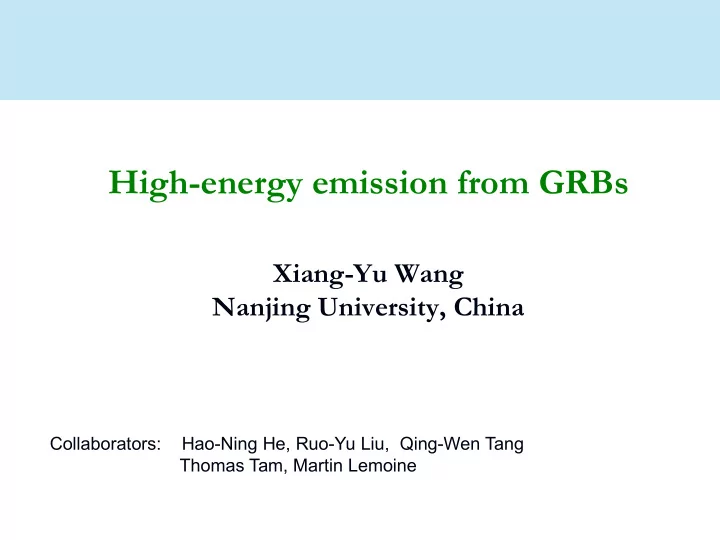

High-energy emission from GRBs Xiang-Yu Wang Nanjing University, China Collaborators: Hao-Ning He, Ruo-Yu Liu, Qing-Wen Tang Thomas Tam, Martin Lemoine
Gamma-ray bursts are short-duration flashes of gamma-rays occurring at cosmological distances! 2
Bimodal distribution of durations Short Long Hard Soft 2 s T 90 3
Typical GRB light curves MeV γ -rays Luminosity iso (erg/s) X-rays 10 51 Optical 10 47 ~10 4 ~10 5 ~10 6 ~10 2 t (sec):
GRB popular model: A Summary Gehrels, Piro & Leonard 2002, Scientific American
GRB popular model: A Summary Gehrels, Piro & Leonard 2002, Scientific American
Gravitation wave detection from GW170817/GRB170817A A short GRB 7
Multiwavelength observations of GW170817 8
CR acceleration in GRBs Hillas Plot Credit: P. Meszaros Internal shocks (Waxamn 95) External shocks (Vietri 95)
GRB Neutrino prediction ε p ε ≥ 2 Γ 2 0 . 3 GeV γ H envelope He/CO star p ν ν ν ν γ External shocks Internal shocks Afterglow X,UV,O Prompt γ -ray (GRB) Buried shocks Afterglow ν ’s Burst ν ’s No γ -ray emission Precursor Waxman & Bahcall ’00 Waxman & Bahcall ’97 ν ’s Murase & Nagataki 07 Wang & Dai 09 Razzaque, Meszaros & Waxman ’03 PeV Murase et al. 2013, 2017 EeV TeV
IceCube Neutrinos in coincidence with gamma-ray bursts? IC40, IC59, IC79, IC86-1 ν 506 GRBs Gamma-ray satellites γ, ν Normal-luminosity GRBs contribute to <1% neutrinos ! distant GRB But, no constraints on low- luminosity GRBs and choked jets !
GRB neutrino flux is model- dependent R >4 × 10^12 cm Small dissipation radius scenario (e.g. photosphere scenario): -- Challenged Large dissipation radius scenario (e.g. Magnetic dissipation scenario) -- OK (Zhang & Kumar 2013) (He, et al. 2012 But, do not rule out UHECR origin
Fermi satellite Fermi LAT covers energy band (100 MeV to > 300 GeV) 180 GRBs detected in 10yr LAT 34 LAT GRBs with known redshift GBM NaI GBM BGO Fermi Gamma-ray Burst Monitor Views entire unocculted sky NaI: 8 keV - 1 MeV BGO: 200 keV - 40 MeV
Fermi GRB light curves- extended emission GRB090510 GRB130427A >100 MeV: much more extended Fermi collaboration 2013 De Pasquale, et al. 2010 14
Synchrotron afterglow scenario ? (Kumar & Barniol Duran 09, Ghisellini et al. 09, Wang et al. 10) afterglow synchrotron emission to account for all the LAT emission: Simple PL decay: similar to X-ray/optical afterglows Synchrotron flux could match the observed level (Kumar & Barniol Duran 09) 15
Broadband modeling Dynamics: Relativistic blast wave radiation Radiation: Synchrotron, IC ISM(wind) Input parameters: E, θ , Γ , n, p, ε _e, ε _B 16
Detailed broadband modeling… (He, Toma, Wu, Wang & Meszaros 2011; Liu & Wang 2011) GRB090510 GRB090902B GRB090510 At early time, afterglow synchrotron emission model falls below the observed flux -> Internal origin 17
Correlated spikes seen by Fermi Support internal origin for the early prompt LAT emission Abdo et al. 2011 18
Detailed broadband modeling… (He, Toma, Wu, Wang & Meszaros 2011; Liu & Wang 2011) GRB0900902B GRB090510 GRB090902B GRB090510 At early time, afterglow synchrotron emission model falls below the observed flux -> Internal origin For late GeV emission, the afterglow synchrotron scenario fits the data well 19
One issue for the synchrotron scenario of late GeV emission Expected: maximum synchrotron energy: ~50 MeV in the shock rest frame (Bohm acceleration approximation) Observer frame : 50MeVx Γ , Γ <100 at 1-10ks Observed: E_max~5GeV at 1-10ks >10 GeV photons challenge the synchrotron scenario (e.g. Piran & Nakar 10; see, however, Kumar 2014) 20
Even worse … (Lemoine 2012) Bohm approximation breaks down for microturblence magnetic field Lead to an even lower maximum synchrotron energy… 21
GRB130427A Fermi collaboration 2013 - the brightest GRB so far Maximum synchrotron energy limit Ackermann et al. 2013, Science
Origin of >10 GeV photons ? A natural way out : Electron inverse Compton (IC) processes: Afterglow synchrotron self-Compton (SSC) emission (Zhang & Meszaros 2001; Wang, Liu & Lemoine 2103;…) 23
Synchrotron + SSC components (Wang, Liu & Lemoine 2103) The SSC intensity is sensitive to the circumburst density No obvious flattening seen at the transition 24
Modeling light curves with different ISM densities (Wang, Liu & Lemoine 2103) (Wang, Liu & Lemoine 2103) n = 1.2 cm^−3 n = 0.003 cm^−3 Rapid decay due to limited maximum 90 GeV photon at 80 s comes synchrotron energy from SSC 25
LAT data of 130427A (Tam, Tang, Hou, Liu & Wang 2013) (Fermi collaboration 2013) Possible signature of Interpreted as spectral spectral hardening at ~10 hardening GeV (~2.9 σ for 3-80 ks)
Broad-band modeling: Synchrotron + IC components (Liu et al. 2103) GRB 130427A 2 7
100 GeV flux Liu et al. 2013 Below ~3GeV, synchrotron flux is still the dominant component VERITAS data at 70ks inconsistent with SSC ? Aliu et al. 2014 SSC flux @100GeV is 3*10^-8 erg/cm^2/s at t~200s F(100GeV)~t^-1.35 At 70 ks, SSC flux @100GeV is 1.1*10^-11 erg/cm^2/s SSC model not ruled out… 28
GRB190114C: Magic sub-TeV Mirzoyan + 19
LHAAS LH AASO WFCTA: 18 Cherenkov telescopes (1024 KM2A: pixels/telescope) • 5195 Scin’s: 1 m 2 , 15m spacing • 1171 MDs: 36 WCDA: m 2 , 30m spacing 3120 cells (25m 2 /cell) Daochen, 4410 m a.s.l., 600 g/cm 2 (29 o 21’ 31” N, 100 o 08’15” E) 2019/5/21
Construction status A glance from sky: 1/4 array is there ! 31
Water Cherenkov Detector Array (big ponds) Three ponds will be built in this year. The 1 st has been filled up and turned on for operation Valentia Event ! 32
Ground Wide Angle Cameras System SVOM GWAC Ground Wide Angle Cameras System (GWAC) is the follow-up telescope of SVOM, already in use GWAC includes 40 18-cm telescopes , partly supported by Nanjing University Thank you!
Recommend
More recommend